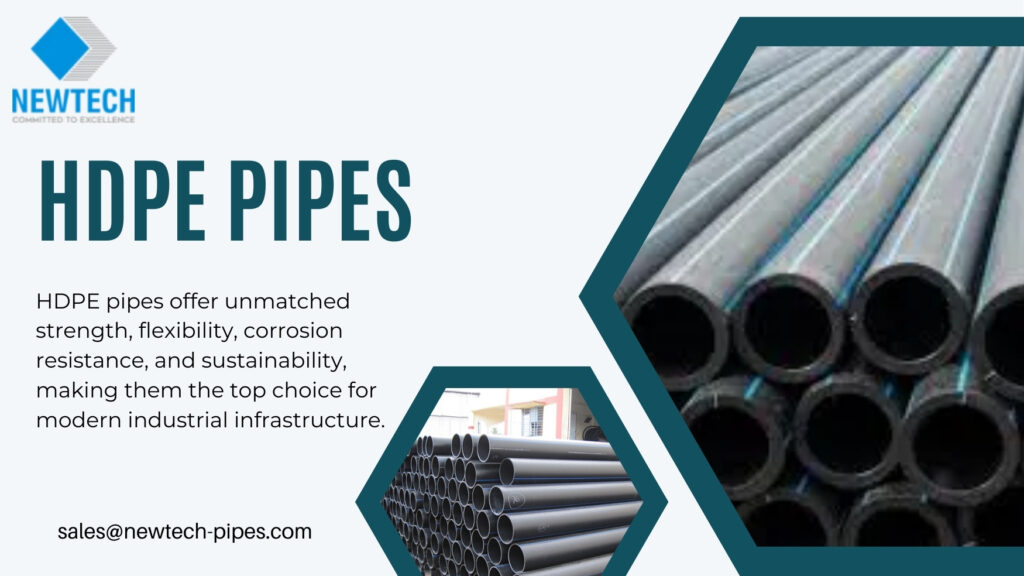HDPE pipes outperform traditional materials due to their flexibility, leak-proof joints, corrosion resistance, and suitability for high-impact environments. They’re ideal for water, gas, agriculture, and telecom systems. Lightweight and recyclable, HDPE supports energy-efficient installation and future-ready infrastructure, making it a sustainable, cost-effective solution for modern industrial applications.
Why are HDPE pipes the foundation of modern industrial infrastructure?
In preparing any big project—be it building construction, irrigation system installation, or city utility maintenance—the type of piping used as material will become a make-or-break point to success over time. A pipe of the wrong material may necessitate repair costs, endanger the environment, and require routine servicing. Why is HDPE (High-Density Polyethylene) the wisest choice available today?
At New Tech, we’ve serviced a broad variety of industries that require strength, flexibility, and safety from their piping systems. HDPE performs on all levels. Let’s explore the number one reasons why it remains the solution of choice for today’s industrial and commercial piping needs.
Why are HDPE pipes taking over traditional piping systems in commercial industries?
1. Better Material Flexibility
HDPE pipes are constructed of thermoplastic polyethylene, which provides an unrivaled flexibility over rigid materials such as PVC, metal, or concrete. This renders them shock-absorbing, ideal for underground or high-impact use. HDPE does not crack under earth movement, vibration, or pressure fluctuations like brittle materials do.
2. No Rust, No Rot
In applications where piping exposure to chemicals, water, or extreme weather is the norm, corrosion resistance is of utmost importance. HDPE piping provides non-corrosive operation, free of rust, pitting, or microbial development—a problem that afflicts metal piping.
3. Leak-Free Jointing with No Leak Potential
By butt fusion or electrofusion, HDPE pipes are joined without chemicals, adhesives, or mechanical connections. This forms a monolithic system with resistance to leaks, pressure failures, and infiltration—essential in oil, gas, and chemical applications.
Why does HDPE excel over other piping materials in high-demanding situations?
1. HDPE vs. Metal Pipes
Metal pipes are strong but heavy, costly, and over time corrode. They also conduct heat and, as a consequence, have effects on conveyed material. HDPE is easy to install, not conductive, and lightweight, lowering costs of installation to a maximum of 30%.
2. HDPE compared to Concrete Pipes
Concrete, as it’s very strong, but rigid, can crack easily. HDPE is elastic in nature and, most importantly, is resistant to chemicals, thereby perfectly suitable where there is frequent seismic activity or even acidic/alkaline wastes are transported.
3. HDPE vs. PVC
Household plumbing applications are commonly employed with PVC pipes, but when it comes to heavy-duty systems, HDPE’s superior tensile strength, pressure resistance, and UV resistance provide it a clear advantage. HDPE is also more environmentally friendly because of its recyclable nature.
Which are the best industrial and commercial applications of HDPE pipes at present?
1. Water and Waste Management Systems
HDPE pipes are root-resistant and leak-proof, hence the most sought-after for use in urban water supply lines, sewage transport, and storm drainage.
2. Irrigation Networks and Agriculture
Agriculture depends on strong, UV-resistant pipes that are able to deliver under the sun. HDPE pipes are used extensively for underground channels, sprinkler lines, and drip irrigation, particularly in high-pressure systems.
3. Mining and Slurry Transport
Mining activities encounter abrasive slurry mixtures and high-stress conditions. The abrasion resistance of HDPE and its chemical inertness qualify it to carry rock-filled slurry without being eroded.
4. Oil and Gas Applications
Pipeline lining to carrying petroleum products, HDPE’s flawless fusion technology eliminates contamination or leakage in hazardous environments.
5. Telecommunications and Cable Protection
HDPE pipes serve as conduits for fiber optic and electrical cable wiring, protecting them from moisture, rodents, and physical stress—ideal for underground cabling.
Why are HDPE pipes eco-friendly and future-proof?
1. 100% Recyclable and Sustainable
Sustainability is a top priority at New Tech. HDPE pipes are recyclable and non-toxic, lowering the carbon footprint of construction initiatives. At the end of their life cycle, they can be melted and reused without compromising on mechanical properties.
2. Energy-Efficient Installation
HDPE light weightlessness saves fuel and labor expenses in transportation and installation. Fewer joints require less time and resources to join piping systems.
3. Compatible with Smart Infrastructure
Smart city infrastructure is compatible with sensors, flow meters, and automated monitoring systems due to the non-interfering nature and flexibility of HDPE pipes. They suit digital water management systems and automated leak detection.
Final Thoughts: Why New Tech Recommends HDPE for Your Next Big Project
Whether you’re designing infrastructure for a factory, farm, city, or data center, the material you use needs to hold up to the test of time. HDPE pipes meet every requirement—strong, long-lasting, leak-free, flexible, safe, and environmentally friendly.
At New Tech, we’ve seen HDPE revolutionize industrial piping systems across Pakistan and beyond. From reducing operational costs to improving long-term safety, HDPE proves time and again that it’s built not just for today—but for the demands of tomorrow.


